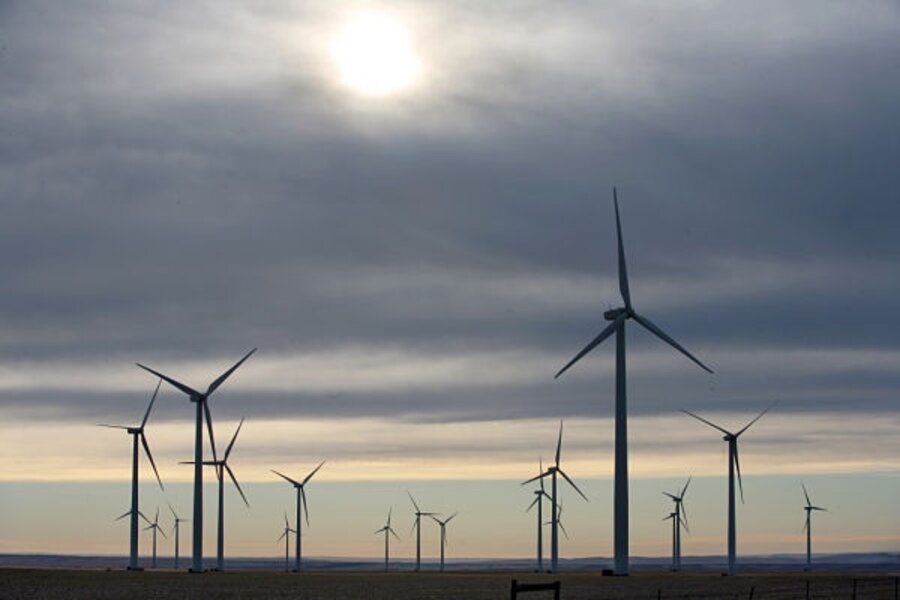Can large wind farms tweak weather downwind?
Loading...
A battle over a wind farm in our backyard – off the island of Martha's Vineyard – has shown that folks can raise a host of objections over unintended consequences, real or imagined.
They've included hazards to boaters, hazards to endangered migratory birds, hazards to aircraft flying between the Vineyard and the mainland, and of course, hazards to the property value of big-buck homes with scenic views of Nantucket Sound. Oh yes, one can't forget the installation of transmission lines to link the turbines to the utility grid. And that's just for one relatively small wind farm.
Now researchers are looking at another potential "unintended consequence" – the likelihood that collectively, groups of large wind farms in one region could alter weather patterns downwind of the turbines in another region.
So far, evidence suggests that large collections of wind farms could have small but measurable effects on atmospheric circulation patterns, cloudiness, and temperatures over substantial distances.
"If you have a couple of wind farms over a 10-kilometer patch in the Midwest, that's not going to make some kind of global impact on the weather," says Daniel Kirk-Davidoff, an atmospheric scientist at the University of Maryland, College Park, who works on the issue. But if the whole Midwest "is somewhat roughened over a large area, then you could imagine having a large-scale impact on the atmosphere."
At this stage, he says, the results from his and other studies are reassuring: It looks as if any regional or global effect would be tiny, especially compared with changes anticipated from global warming. And the effects are small compared with the benefits to the climate of giving fossil fuels – especially coal – the heave-ho in favor of energy sources that don't release greenhouse gases, noticeably carbon dioxide.
But instead of packing up their computers and data and calling it a day, he and his colleagues are trying to refine their estimates with an eye toward wind farms of the future – "how to design wind farms in ways that make them innocuous," he says. One such study, in pdf form, is under discussion and review for publication at the website for the journal Atmospheric Chemistry and Physics.
Wind energy's potential
The impetus for such work: Studies highlighting the potential role wind turbines can play as climate-friendly sources of electricity. For a peek at the most recent estimates, journey over to the journal Proceedings of the National Academy of Sciences for a free pdf of the formal research paper published earlier this week.
The study was conducted by scientists from Harvard University and the VTT Technical Research Centre of Finland.
The short take: After a variety of calculations, they find that large assemblages of 2.5 megawatt land-based turbines in the right regions would meet more than 40 times the world's current electricity needs. And that's with turbines running at no more than 20 percent efficiency. They looked at the US specifically and estimated that wind energy could meet up to 16 times the current US demand for electricity.
At first blush, the thought of vast collections of wind farms affecting weather patterns seems a bit far-fetched. But scientists have long studied the effects that changes in the roughness of Earth's surface can have on low-level wind patterns. And large, regional collections of wind turbines would rough up the surface. In effect, it's like planting very tall trees (roughly 300 feet high).
But what about the weather?
An early study of the impact that large collections of wind farms might have came out in 2004. A team from the University of Calgary, Carnegie Mellon University, Princeton University, and the National Center for Atmospheric Research explored the effect of what it termed "large amounts of wind power" and found a "non-negligible climatic change on continental scales." In this case, the changes involved atmospheric circulation patterns.
Last year, Mr. Kirk-Davidoff and a colleague, took a more detailed look to figure out how and why the climate changed. They looked at an expanse of wind farms roughly equal to the typical expanse for storm systems that move across North America. Essentially, surface winds and those somewhat higher in the atmosphere slowed as they crossed the region hosting the wind farms. They found that the presence of rougher landscape over large areas introduced "appreciable" changes in wind, temperature, and cloudiness.
How far afield are those changes found? In the study Kirk-Davidoff currently has under review, increased roughness over North America appears to trigger "substantial changes" in the development of storms over the North Atlantic and the tracks they follow. Substantial means that the size of the change is larger than typical weather-forecast uncertainties. The amount of roughness the wind farms present could be controlled by the way operators orient the turbines to the wind.
Still 'pretty speculative'
At the moment, Kirk-Davidoff acknowledges, the work is "pretty speculative." Real-world measurements of wind farms' effect on wind patterns are few and far between. In 2005, scientists in Europe published a study of the effects that large off-shore wind farms had on wind patterns, using satellite-based radar. But no one so far has built collections of wind farms on continental scales.
Yet "the possibility of relying heavily on wind power is not unreasonable," he says – especially in light of wind-energy's potential as outlined in the paper from the Proceedings of the National Academy of Sciences.
For Kirk-Davidoff, his work involves examining potential unintended consequences – at least the ones people can think up – "as the technology ramps up, so hopefully we don't get into really surprising consequences before we have a chance to realize what they might be."





